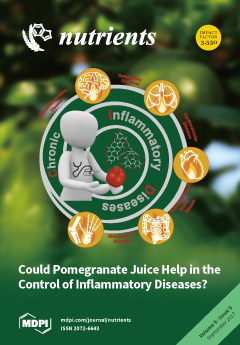1
Department of Nutrition Science, Purdue University, Room 143, 700 West State Street, West Lafayette, IN 47906, USA
2
Department of Preventive Cardiology, Medizinische Klinik and Poliklinik I, Campus Innenstadt, Ludwig Maximilians University, Ziemssen str.1, D-80336 Munich, Germany
3
Department of Medicine, Sanford School of Medicine, University of South Dakota, Health Science Center, 1400 West 22nd Street, Sioux Falls, SD 57105, USA
4
OmegaQuant Analytics, LLC, 5009 W. 12th Street, Suite 8, Sioux Falls, SD 57106, USA
5
Jefferson Women’s Primary, 211 S. 9th Street, Walnut Towers, Ste. 401, Philadelphia, PA 19107, USA
6
Grub4Life and People Matter TV, 40 Bowling Green Lane, Clerkenwell, London EC1R 0NE, UK
7
Women and Heart Disease Center, Lenox Hill Hospital, 110 East 59th Street, New York, NY 10022, USA
8
Department of Nutrition and Integrative Physiology, University of Utah, 201 South Presidents Circle Room 201, Salt Lake City, UT 84112, USA
9
Department of Nutrition Science, Purdue University, Stone Hall, Room 143A, 700 West State Street, West Lafayette, IN 47906, USA
†
Former address: Reckitt Benckiser North America Inc., Morris Corporate Center IV, 399 Interpace Parkway, P.O. Box 225, Parsippany, NJ 07054, USA.
Abstract
Little is known about the relationship between perceptions of nutrient adequacy and biomarkers of nutrition status. This cross-sectional study of U.S. and German adults (
n = 200; 18–80 years) compared dietary practices, knowledge, and beliefs of omega-3 fatty acids (O3-FA) with the
[...] Read more.
Little is known about the relationship between perceptions of nutrient adequacy and biomarkers of nutrition status. This cross-sectional study of U.S. and German adults (
n = 200; 18–80 years) compared dietary practices, knowledge, and beliefs of omega-3 fatty acids (O3-FA) with the omega-3 index (O3-I), an erythrocyte-based biomarker associated with cardiovascular disease (CVD) risk. More than half of adults believed that O3-FAs are beneficial for heart and brain health and could correctly identify the food sources of O3-FA. However, the mean O3-I in the U.S. (4.3%) and Germany (5.5%) puts the majority of adults sampled (99%) in intermediate or high CVD-risk categories. More Americans were considered at high CVD-risk (40%) when compared with Germans (10%). In the U.S., but not Germany, women had a significantly higher O3-I than men (4.8% vs. 3.8%,
p < 0.001). In the intermediate CVD-risk group, about one-third of adults in both countries (30% in the U.S. and 27% in Germany) believed their diet was adequate in O3-FA. Notably, mean O3-I concentrations did not significantly differ with dietary perceptions of adequacy. More adults in Germany (26%) than in the U.S. (10%) believed that dietary supplements are needed to achieve a balanced diet. In spite of adequate knowledge about food sources and a consistent belief that O3-FA are important for health, very few participants had O3-I concentrations in the range for CVD protection.
Full article






